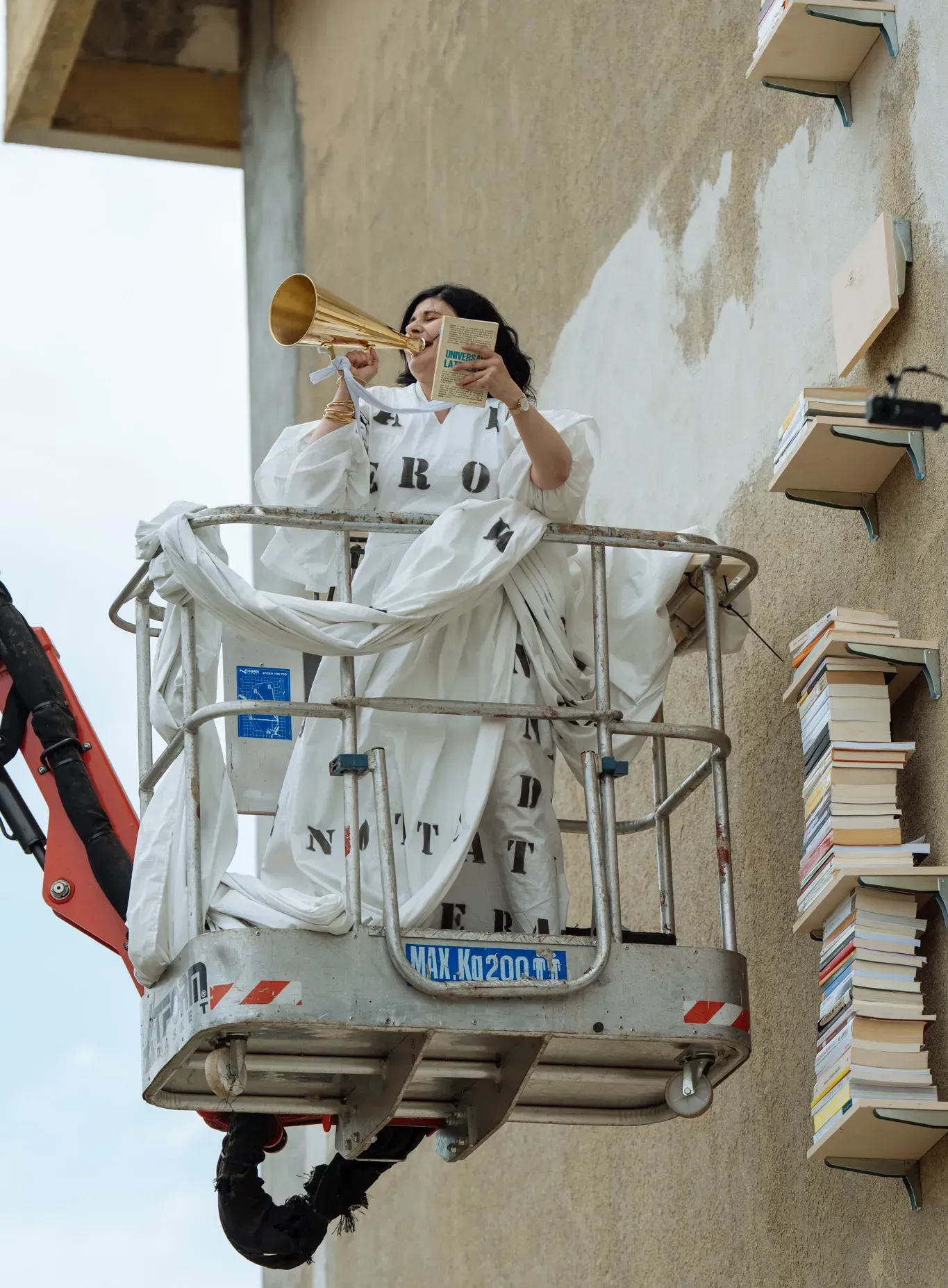 Nezaket Ekici, Book Tower, Performance Installation 2025. Presented at the Performing Festival, Accademia di Belle Arti di Catanzaro, 24.5.2025. Curated by Dobrila Denegri. Photo: Andreas Dammertz, courtesy of Accademia di Belle Arti di Catanzaro.
Nezaket Ekici, Book Tower, Performance Installation 2025. Presented at the Performing Festival, Accademia di Belle Arti di Catanzaro, 24.5.2025. Curated by Dobrila Denegri. Photo: Andreas Dammertz, courtesy of Accademia di Belle Arti di Catanzaro. Libraries, places where time folds in on itself, are perceived as witnesses to history. However, they flirt with the idea of becoming history themselves. Libraries are as much spaces of forgetting as they are of remembering. This place, where pages upon pages of memory-images are imprisoned between thick-bound covers, grows more conservative about revealing information the older it gets. These structures, which turn into time tunnels as history accumulates upon them, are also selective about who gets to journey through time within them. Contrary to its characteristic of not accepting "everyone," it is believed that libraries will define a better future for "everyone" (the whole world).
Turkish-born and German-based artist Nezaket Ekici invites us to contemplate the bridge that libraries build between the past and the future with full of contradictions, by her performance entitled Book Tower, curated by Dobrila Denegri at the Accademia di Belle Arti di Catanzaro Performing Festival. The artist reveals knowledge that becomes increasingly sacred with each passing era, its sanctity polished by being protected and hidden behind closed doors. She highlightes for the audience how knowledge should be accessible and brought into question for everyone. Unlike academic structures, it intervenes in institutions, academia, and the memory system of academia through performance art, which is a more permeable and collective form.
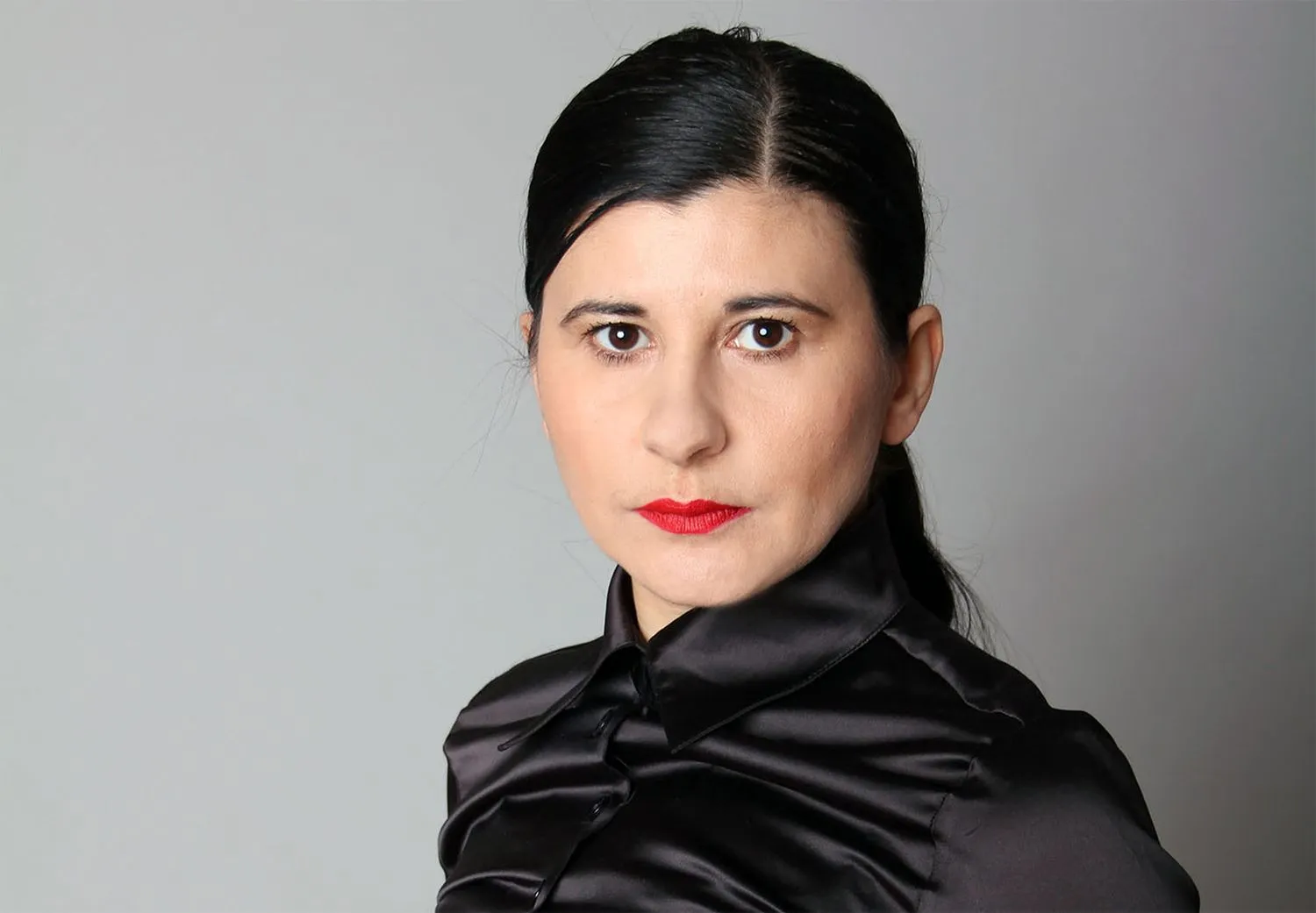
Tuğçe Arslan: You presented your performance Book Tower at the Accademia di Belle Arti di Catanzaro during the Performing Festival in Southern Italy. This work lends itself to multiple interpretations through the intersection of concepts such as "knowledge-documentation/preservation," "inside-outside," "history-memory," and "individual-society." I would like to discuss Book Tower through the various layers these concepts reveal.
First of all, how did the process begin? How did your journey to Catanzaro, your observations there, and your decision to work with the academy's library as a performance site unfold? What kind of trigger did the library's physical and historical structure present for you?
Nezaket Ekici: I was invited by curator Dobrila Denegri. I first met Dobrila in Belgrade in 2001, when she was curating the exhibition Real Presence-Generation 2001 with her mother, Biljana Tomić, at the 25 May Museum and the Museum of Modern Art in Belgrade. At during that time, I was a student in the Abramović Class and had the opportunity to present my performance Catch a Turkish Kiss for the first time in this exhibition curated by Dobrila and Biljana. In 2012, we met again in Poland, where Dobrila was the director of the Centre for Contemporary Art (CoCA) in Torun. She has been curating a live theatre exhibition, when I presented my performance Imagine for the first time. This year, 2025, will have marked our third collaboration. Dobrila, who is working as a professor at the Accademia di Belle Arti di Catanzaro, organized a major Performing Festival in Catanzaro along with her colleagues and team and she had invited me to join them. After this invitation, I decided to accept contributing with a workshop and a performance as part of the festival.
But before the festival, I needed to do some research. I didn't know the city at all—actually, I didn't know Southern Italy or Calabria at all. So, in March 2025, I traveled to Catanzaro, the capital of Calabria, for three days to conduct research. That was a crucial step for me. During these three days, the team took me around the city—parks, museums, and finally, the library Biblioteca Comunale Filippo De Nobili. In fact, it is only library in the city. While it operates with the openness of a public library, access to the archives is restricted to scholars, academics, or students.
I had not previously come across anything comparable. There is a second room with a large storage area, a large archive, and only security can open the door in the library. I had never encountered a room like this. Towering ten meters high, books were stacked floor to ceiling on layered stairways. They called it the "Book Tower." I couldn't believe my eyes—there were books dating back to the 1500s, preserved under protective covers. The newer books were kept on the lower levels. There was a clear hierarchy—not in terms of the value or significance of knowledge, as that is not for us to judge—but rather one based on age: the older the book, the higher it was placed. The library completely captivated me. I wanted to bring its effect out into the open and share it with others. Most people in the city weren’t even aware the library existed not even the students I was working with. When I took them there for field research, they were shocked. The interior of the library was a revelation to them. In other words, I opened the door to the "Book Tower" for them.
TA: Transposing a space of knowledge, like a library—typically defined by its interiority—into the public realm means making an invisible architecture of knowledge visible. Reconstructing such a silent and closed structure through open-air, bodily action creates not only just a spatial gesture, but also one concerning the publicness of academic knowledge. What is the significance of this gesture within your artistic practice?
NE: It's like revealing a secret. In my view, sharing knowledge is crucial—but it's not only about that. It's also about learning new things, not keeping them to myself, but putting them "out there." That's what I mean by sharing. It's also about content—not just showing books but speaking about what is in their inside. So, in the performance, I didn't merely display the books—I read them as well. I also asked the students who were involved in the performance to read excerpts aloud. The goal wasn't simply to take the books outside, but to carry the knowledge within them into public space. That's where the depth comes in. You know, some of my earlier works have also dealt with knowledge.

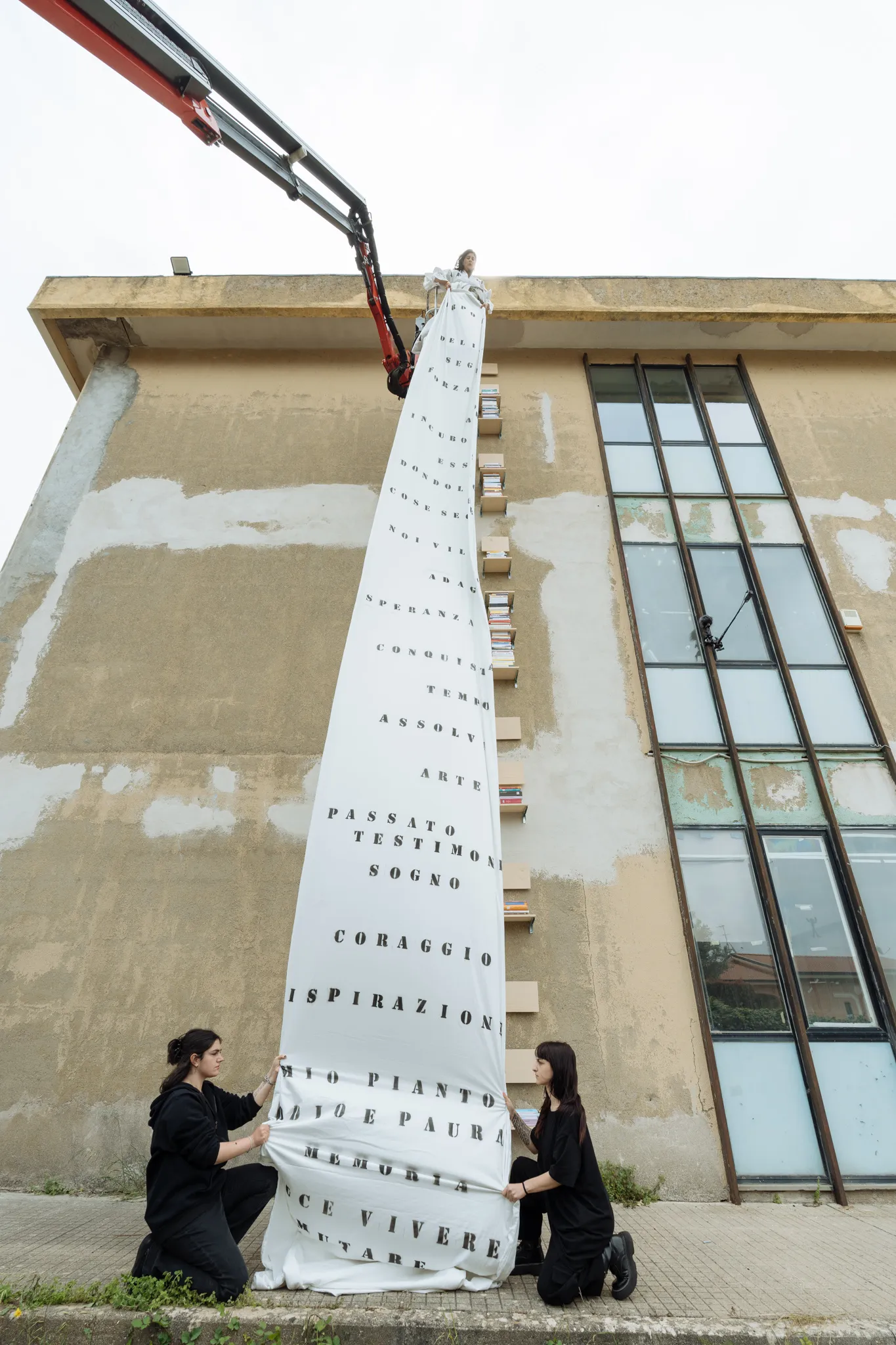
TA: Yes, I will get to that at the moment—but before going further, I'd like to highlight something: In this performance, you become both a "book figure" and a part of the system that symbolizes the circulation of knowledge. In this sense, the performance proposes both a form of representation and transmission. What was it like to use your body as a symbolic vessel for knowledge circulation? How do you connect the body to notions of memory, the archive, and knowledge?
NE: Like I said earlier, it wasn't just about revealing the library—it was also about revealing the book. I am the book, and I give a voice to myself/the book. I transmit knowledge. I feel like a vessel for knowledge, and passing it on feels like a responsibility. Much of my work is built on that idea. I want to keep what I have learned alive and also learn from others. It's a give-and-take dynamic, and I deeply value that when it comes to knowledge. This relationship between body, memory, and knowledge isn't limited to my artist's body—it's something I try to carry into my everyday life as well.
TA: Your performance also offers a form of public reading: students, books, inscribed garments, and a collective construction. If we consider your dual identity as both artist and educator, how did this collaborative process intersect with your pedagogical approaches? What potential do you think lies in the convergence of performance and education?
NE: As you know, I have studied Art Pedagogy and hold a Master's Degree in this field. In addition to being a freelance lecturer in the field of art and performance art at universities in different cities around the world, I have given more than forty performance art workshops worldwide—on four continents, in various cultures. These include countries such as Brazil, Vietnam, Europe, Africa, and many different groups such as children, elderly, housewives, students, etc. I truly value human diversity. Being with people and sharing my art with them is priceless for me.
I'd like to mention First Contact that was one of my a workshop approach. That was also based on a workshop approach. Strangers opened their homes doors to me, and I shared performance art with them in their own space—they even participated. I always say that in performance art, some concepts are key: concentration, courage, and limits. I teach those who work with me how to push physical and mental boundaries in a focused and brave way. Also, sometimes in my performance art workshops, I create concepts in which students re-enact parts of my performances; I'm curious to see how they interpret them. Everyone perceives things differently. I invite students to offer their own ideas, produce their own concepts, and learn the philosophy behind performance. Deepening that intellectual layer is essential to me.
Regarding Catanzaro in particular, I have to mention the language barrier. I speak some Italian, but not fluently enough to teach in it. So, I ended up speaking half-English, half-Italian for five days— it was very challenging. Despite it being learning experience. We pushed the boundaries of language, and sometimes even it has been a mutual misunderstanding.
TA: A significant dimension of the performance is shaped by physical risk and unpredictability: wind, height, cranes, fabric... How do you interpret the relationship between these uncontrollable elements and your body? What do these edge experiences mean to you aesthetically and ethically within the context of performance art?
NE: Normally I enjoy pushing limits—but in this case, much of it happened beyond my intention. I was forced to push myself. The very act of ascending and descending a 12-meter facade by crane is physically demanding. I did it to understand and embody the physicality of the building—to convey its verticality through my own body.
Height isn't just a number. Looking down from above is a totally different experience than looking up from below. I didn’t even know that I had a fear of heights! And then there was the wind—Catanzaro is known for its strong winds because it lies between the Ionian Sea and the Sila Mountains. The wind became an active participant. It turned my dress into a kind of sail. I couldn’t resist the collaboration between fabric and air. People were watching very anxiously, but I love transmitting and sharing such intense emotions.
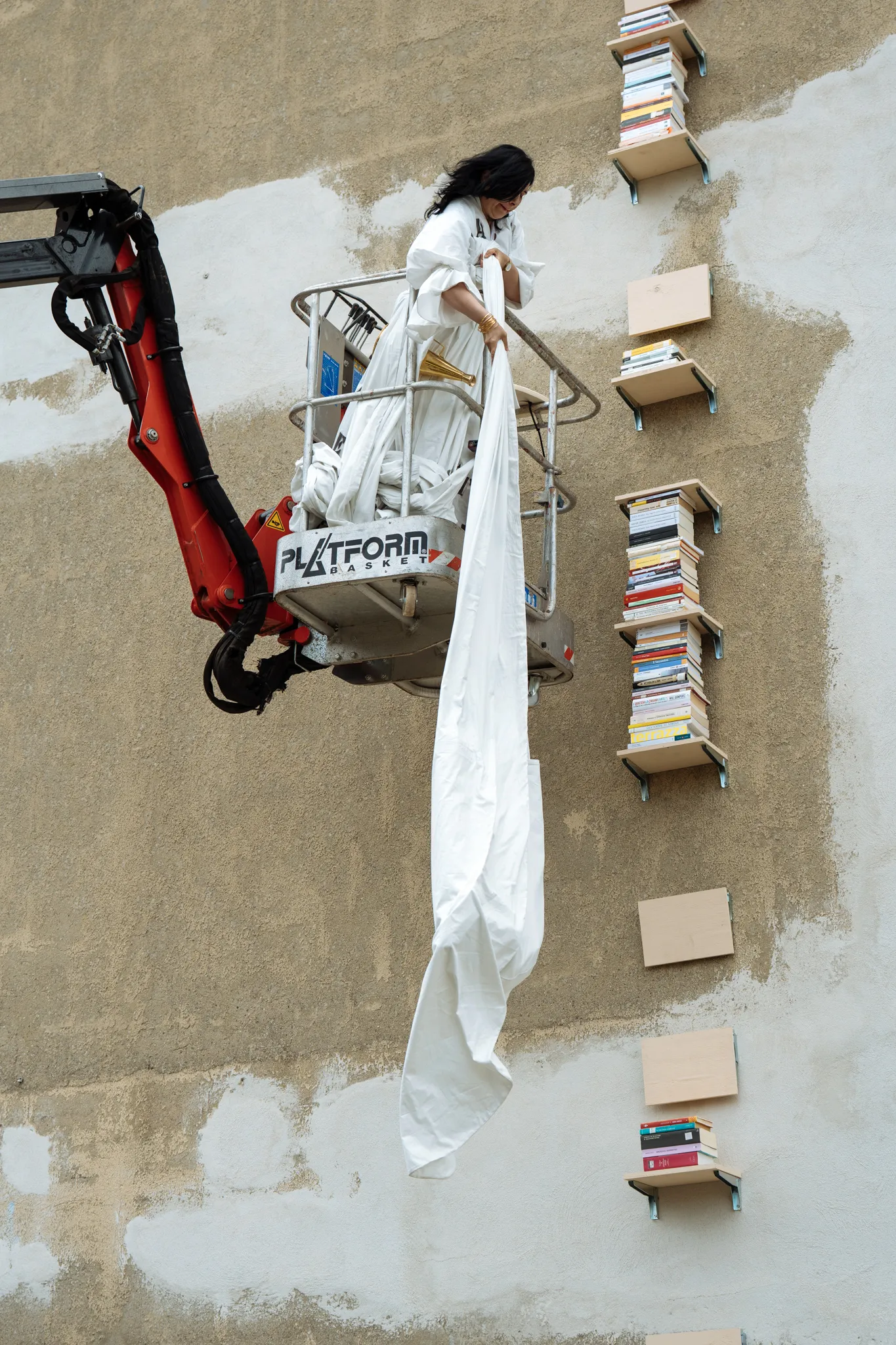
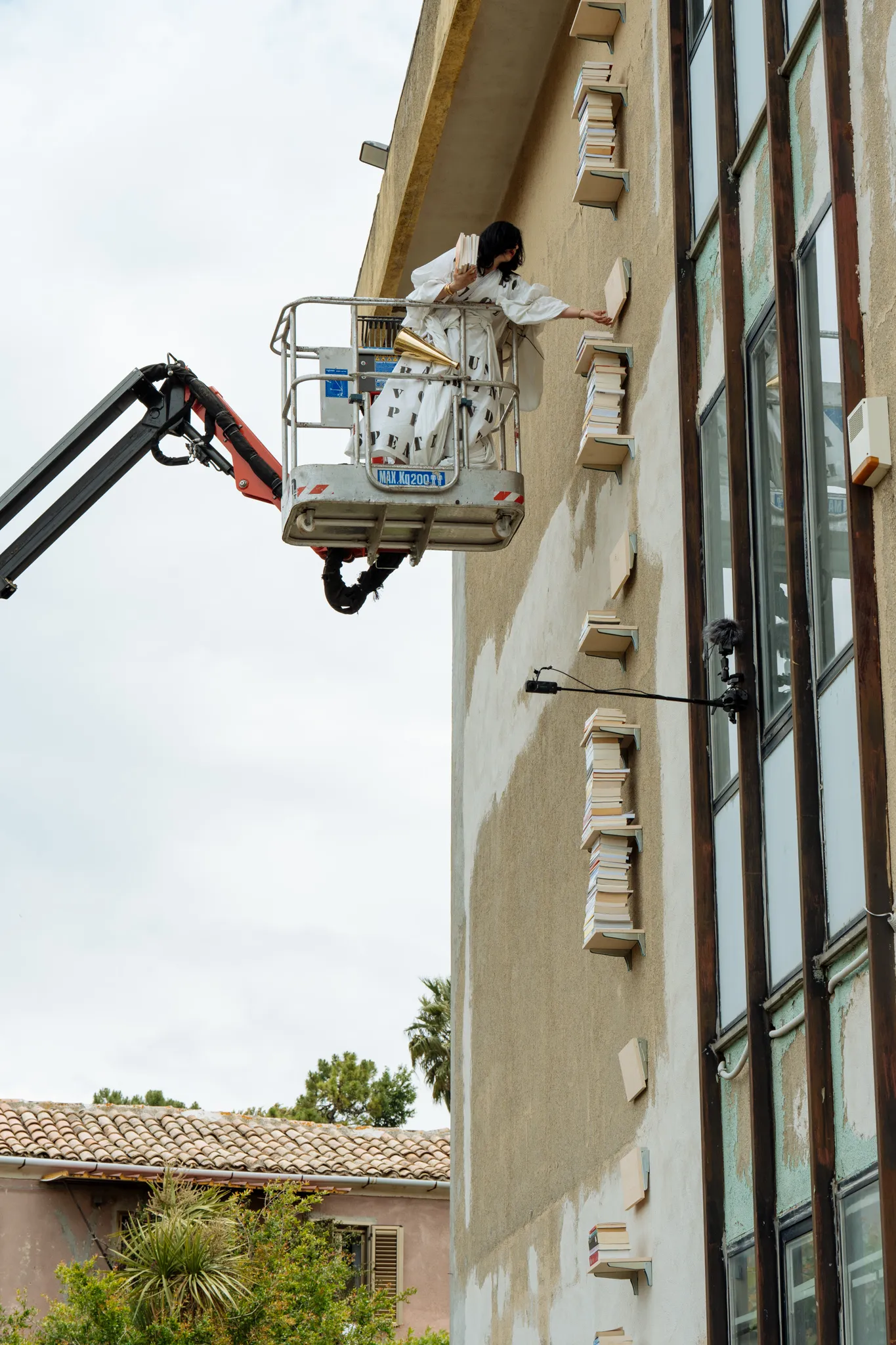
TA: Your 12-meter-long garment functions both as a sculptural structure integrated with the site and as a conceptual tool attached to the body. You designed it not merely as a costume but also as a vessel of meaning. In this work, what metaphorical role did the costume play?
NE: In one sense, I was a book. When you open a book, you see and read the words—that's the most basic level. On the other hand, I was also a carrier. I could have done this with something like a basket instead of a long dress, but I chose to add an apron to the dress. I used this long apron to carry books—almost like a rope. The apron had a pocket where I placed books and pulled them up. At that point, the costume became a book itself. The fabric’s weight turned into the weight of the knowledge it carried. So fundamentally, with this costume, I was both a book and a bearer of knowledge.
TA: Book Tower weaves together ideas of collective creation, knowledge transmission, public intervention, and bodily experience. In this respect, it establishes a relationship with your previous works on the subject we just mentioned but did not elaborate on. In what ways does this work relate to your previous performances? Which aspects of your practice do you think this work carries into a new context?
NE: As I mentioned earlier, this wasn't the first time I addressed the transmission of knowledge in my work. For example, in 2007 I did a performance called Sinnlicht—which we can translate as Sense Light, a poetically conceived artificial word in German, meaning "to understand the word without seeing it"—at the public library Wilhelmspalais in Stuttgart. The first sentence I used was "Am Anfang war das Wort" (In the beginning was the Word) of the Bible. While re-enacting Leonardo da Vinci's Last Supper as a performance, I sat with twelve people—just like in the painting. Each had their eyes covered, and in front of them were plates with bread shaped like letters. Since they couldn't see, they had to feel the letters to guess them. When the thirteen letters were correctly aligned, the word Nächstenliebe appeared—meaning "love of neighbor." I think it's one of the most important phrases in the Bible, yet it's often overlooked. That word itself implies collectivity and togetherness.
I also explored knowledge transmission in my performances such as in Honey Project (2018), TBQ (Torah, Bible, Quran) with Holy Books (2019) collaboration works with Shahar Marcus, or Layers (2022), and Prothese (2017), among others.
TA: The performance took place in Catanzaro, a southern city "between two seas." How did this spatial and cultural context add another layer to your work? What associations did working in a southern city evoke for you, and how did the location shape the piece?
NE: Let me start by saying that the people were incredibly warm and sincere—definitely something that comes from the South. They were generous and helpful. Although Calabria is often portrayed as a dangerous place, I never felt unsafe. The natural surroundings—the water, landscape, vegetation, and sea—were stunning. The capital city of Calabria, Catanzaro, is also a historic town with narrow streets that were a joy to explore. What's especially unique is that the city is built on three hills, about 15 kilometers from the sea. Oh, and something else: the city is known for the three V's—Vento (Wind), Velluto (Velvet), and Vitaliano (Santo patrono di San Vitaliano). These represent the city's history, culture, and geography. Isn't that fascinating? But to return to the point—more than the location itself, it was the people's sincerity and welcoming attitude that had the greatest influence on me and the creative process.
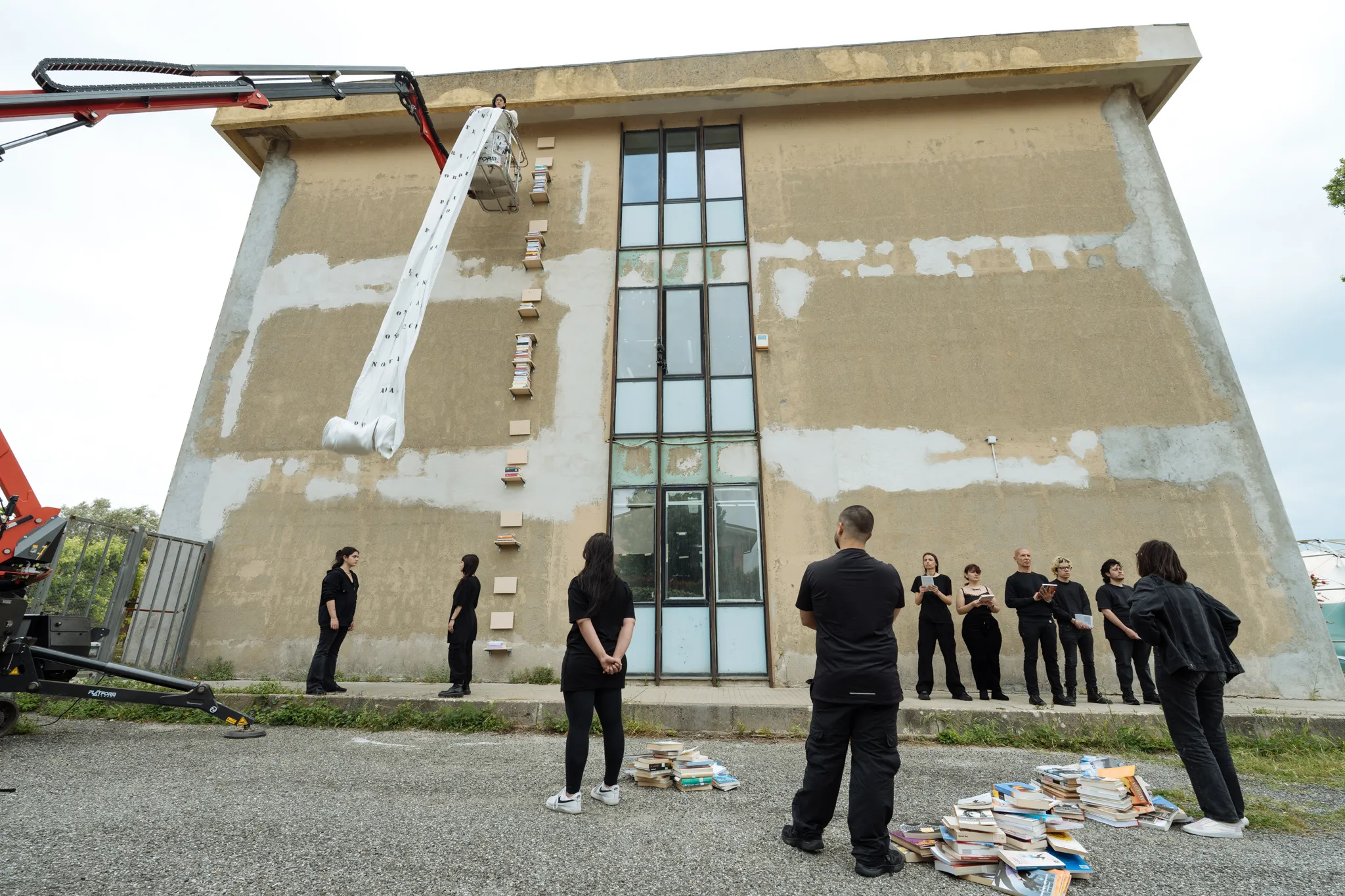
TA: This performance engages not only with a specific building but also with an institution—namely, the Academy—and its memory and systemic structure. In your opinion, how can performance art offer public access or insight into knowledge fields that have historically remained closed?
NE: Honestly, I try to do something meaningful with my art. Likewise in this performance, I aim to bring knowledge out into the open and make it visible. Beyond the books themselves, I'm trying to reveal the human experiences and intellectual labor behind them. People gathered knowledge, studied it, wanted to share it—and that's why they wrote it down. My intervention is about preventing that knowledge from remaining closed off, even if metaphorically. Performance art offers a fertile ground for these kinds of interventions.
TA: Taking the content of an "archival" and "protected" space like a library into the public realm is not only a physical gesture but also a conceptual one. Libraries often represent both the preservation and the inaccessibility of knowledge. In this sense, would you say your performance presents a critique or proposal regarding access to and sharing of knowledge? Does it question the boundaries or sanctity of academic knowledge?
NE: In a way, yes. Knowledge should be accessible to everyone—not just to a selected group. Anyone who has curiosity must have the right to access it. It shouldn’t be restricted to universities or experts. So yes, it's a critique—and we must be able to critique such systems, which also requires knowledge itself. But I'm also offering a suggestion: knowledge belongs to anyone who seeks it, and there are multiple ways to open it up to the world.
TA: Last but not least, performance art—as a public and participatory form—offers a more permeable and collective model compared to academic structures. Do you think this public nature makes performance a more democratic mode of practice? How did your work open up a transitional space between the academy and the public sphere? From your perspective, how does this permeability affect the public potential of art?
NE: To me, this work was democratic in nature. On one hand, it was about making knowledge available—for everyone. On the other, it was about opening it up to interpretation. I came to Catanzaro with an idea, but I listened to the students and shaped the work together with them. That's why performance art is too important—it brings things out into the open. It publicizes them, and I use it as a tool to make knowledge public. Thinking of back to the origins of performance art: Happenings, Fluxus—these all began in public spaces. They moved art out of private or exclusive spheres. I'm following in that tradition. Here too, I took knowledge out of the library, much like stepping out of the white cube. In that sense, performance was the ideal form for this project.
And you know, libraries are known for their silence—but there's also a kind of screaming in that silence. It's as if the books are crying, "Read me, listen to me." They don't want to just sit on shelves; they want to be carried, read, lived. Imagine—some of those books haven’t fulfilled their purpose since the 1500s. The same goes for artworks in museums. As you know, I also do performances based on art history. Paintings hanging in museums, seen only by a select few—they're crying too, wanting to be seen by everyone. To sum up, the journey of my performance Book Tower in Catanzaro started with the publicization of the private, and Book Tower was the perfect idea for my conceptual quest to democratize and open knowledge to interpretation.